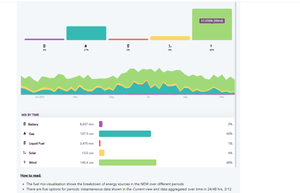
octave
-
Posts
3,932 -
Joined
-
Last visited
-
Days Won
40
Content Type
Profiles
Forums
Gallery
Downloads
Blogs
Events
Our Shop
Movies
Posts posted by octave
-
-
52 minutes ago, Siso said:
Actuators are used for the panels to follow the sun. Some of these have rods that control more than 1 panel.
There are many trials of agrivoltaics going on in Australia and overseas. I
My assumption is that with all these trials going on and some already operating agrivolatic farms that things like the stock damaging the accuators or other parts is a known quantity. I am sure it would not suit every farm type or location, but a search of the net does show sheep and cattle and crops (mainly veges and grape vines, etc where partial shade is preferable.
-
 1
1
-
-
5 minutes ago, old man emu said:
Settle, petal.
I am quite settled. In terms of asking questions, usually the answer is freely available. For example, off the top of my head, I did not know if wind turbine blades contained asbestos. It is not something I had heard, so I sought out the answer.
10 hours ago, octave said:Do you also question what parts of coal power stations are recycled and what is left over when the coal is burnt
Perhaps I should have said "people instead" of "you" to make it more general and less personal. There is a common trend to only question the new, whilst ignoring the problems of the old. Yesterday, in my local area, a car burst into flames. There was a flurry of comments about EVs being unsafe, or "I would never drive one of those things" As it turns out, the vehicle was a petrol Hyundai. As soon as this was established, the outrage and concern evaporated.
-
 1
1
-
-
27 minutes ago, old man emu said:
some people say they contain asbestos
not in the turbine blades; however, some components are found in turbine brake pads. There have been concerns with wind turbine blades in the past; however, new blades are recyclable. Do you also question what parts of coal power stations are recycled and what is left over when the coal is burnt
1 hour ago, Siso said:Solar farms need to be set up to take stock under them as far as guarding around actuators, cable etc.
?
https://www.siemensgamesa.com/global/en/home/explore/journal/recyclable-blade.html
1 hour ago, Siso said:actuators, cable etc.
Acuators? I am not sure exactly what you are referring to. There is no shortage of videos and even long seminars on the net. I will happily post links. Also, a search of farms al; already using agrivoltaics will show many examples both here and overseas.
There are loads of examples both here and overseas. Here are just 2, but do a search yourself. This is a win-win situation. Change can be hard, but it is necessary
-
 1
1
-
 1
1
-
-
21 minutes ago, Siso said:
How many solar farms are set up for agrivoltiacs?
It is early days, but I believe there are a few. Farming has always been a tough way of earning a living. A farmer must decide what they will farm to stay profitable. They can be at the whims of world markets. What better way to diversify than to host renewable power projects? This is drought-proofing a farm.
-
 1
1
-
-
I was not necessarily suggesting the most likely scenario, only suggesting that in SkyNews' world, only one of these causes would whip them up into a frenzy. As for arson being unlikely, I am not sure about that. It is within the realms of possibility, especially with anti-renewable sentiment. It is quite likely that this fire may have been caused by the solar farm or associated equipment. Power lines, whether they are connected to solar or not, are a major cause of fire. Much of the technical equipment we use is capable of catching fire. When this does happen, we analyse and take measures to reduce the likelihood of it happening again.
-
 1
1
-
-
Fires on farms are not unusual. The source could have been from farm equipment, natural sources, arson or from the solar farm. Let's say it was from the solar farm; this surely only means analysis and actions to make it less likely to happen in the future.
Here is a question: Did the incident below make Skynews? No, it did not. This happened a few weeks ago, not far from where I live. There were numerous comments online from conservative folks suggesting that this is a normal process, and sometimes the stack does get smoky for a time. Whether it was normal or not, it did start a grass fire, which required the fire brigade to attend. A grass fire near an oil refinery ought to be big news.
There seems to be a discount applied to existing technologies as opposed to newer ones. A petrol or diesel car catches fire, and it is not a big story. An EV catches fire, and it is huge news and has people suggesting that this technology should not exist.
-
 1
1
-
 2
2
-
-
12 minutes ago, facthunter said:
Those Victorian facilities are for Everyone's eventual Benefit.
Exactly. I travel on the train often, but those who drive their cars instead do benefit from all the travellers who are on the train and not clogging up the roads.
-
 1
1
-
-
As I have said previously, I am not philosophically opposed to nuclear, but amongst other things, an economic case would need to be presented. The other issue is the timeline on nuclear. I get that SMRs are being developed and even a couple are in operation now (Russia and China). How long would it take for us to develop the expertise to build our own, or do we get in the queue to buy one from the Russians, the Chinese or the US?. Until these nuclear options are available and built do we spend money on refurbishing old coal or building new coal? All of the scenarios would result in bigger power bills.
Your link that talks about a "death spiral" and lumps Australia in with Pakistan, I think, is inaccurate. Pakistan’s grid is in trouble because of long-term under-investment, big subsidies, high losses and widespread non-payment. That’s not a rooftop solar problem. Australia doesn’t have those structural issues, and we actually plan our grid developments years in advance through AEMO and the ISP. You did tell me I could not use Denmark as an example because Australia is not Denmark. You know what else it is not Australia? Pakistan
2 hours ago, Siso said:I do definitely think there is a place for intermittent generation, just not at the expense of the generators that can run every day, 24 hour a day.
And in fact, pretty much need to run 24 hours a day. Coal can be somewhat throttled back, you can't really stop burning fuel when demand is low. It is a bit like keeping your car idling in for when you need to go out.
3 hours ago, Siso said:Notice with price dropping they only talk about the wholesale price of electricty, not the actual price to consumers which includes all the extra infrastructure, transmission, syncons etc
Would this be different with the cost of developing and building nuclear?
The predictions of death spirals and the grid falling over are not new. I recall dire warnings that if we had more than 20% renerwables on the grid. The yardstick keeps being moved. When wll th grid fall over (other than the usual faults)?
I dont say that all this is easy (neither is building NP) problems are being solved all the time. Just because we have relied on inertia from coal generators it does not mean that thius is the end point of technological development. We have more and more batteries and grid forming inverters, synchronous condensors etc.
-
15 minutes ago, Siso said:
Notice with price dropping they only talk about the wholesale price of electricty, not the actual price to consumers which includes all the extra infrastructure, transmission, syncons etc
Whatever way we go, there are costs. Do you really think that building nuclear power plants will not impact your bill?
-
 1
1
-
-
29 minutes ago, red750 said:
But that's what the Vic Gov't want. We have a gas hot water system, had it for 45 years. Within a couple of years we'll be required to replace it with electric.
The electric hot water that is installed now is generally not the old-fashioned resistive hot water system, but heat pump hot water systems. These systems are very energy efficient compared to resistive electric or gas.
I believe there are substantial rebates for upgrading to a heat pump, so probably worth looking into.
-
 1
1
-
-
1 hour ago, Siso said:
Who cares about wholesale except for lying politicians, I know I certainly don't. What matters is what is delivered to the consumer!
The cost of electricity comprises direct generation costs plus the infrastructure required to distribute it and retail costs. Electricity could be extremely cheap if we decided not to extend the grid or if we reduced maintenance standards. We could decide what level of resilience we are willing to pay for. Do you think building new coal, gas, or nuclear power would reduce your bills? Would we pay through higher power bills or through our taxes?
The Iberian Peninsula power cut is very complex. As the video you posted suggests, there were many failings. Even if the chain of events were precipitated by a component of the renewable system (and I don't think that is universally accepted) do we say "Oh, a failure, let's rip out the renewables and build more coal"? I think a better course of action would be to say "what went wrong and how we can prevent it from happening again."
If your car breaks down, you don't swap it for a horse, even though horses were adequate transport back in the day.
I imagine neither of us will suddenly change our minds, and the move towards renewables is not likely to stop and be reversed. When I post, I spend considerable time making sure my posts can be supported by references. This makes this a time-consuming activity. I think I might schedule a reminder email to myself, and I could gather as many stats of, let's say June and December (to capture high and low solar) and look for records of grid failures and see if there is a trend and if so, in what direction. Could also record price, both spot and retail (as well as daily connection charges)
-
 3
3
-
-
Here is a graph of the energy mix for SA for last year.
To perhaps oversimplify the argument somewhat. Some people appear to want the green, orange and purple (wind and solar) or in other words, the methods of generation that do not require fuel to be transported and burned, but would rather the teal colour to be 3 times higher.
As I see it, the objections to producing electricity without transporting or burning fuel are reliability and cost.
On reliability, I can't really find evidence that states with more renewables have a less reliable grid. I do have a basic understanding of maintaining grid frequency. This is why synchronous condensors, grid forming inverters and batteries are being installed.
17 hours ago, Siso said:We saw what happened in Spain when a solar inverter started to fail and put stupid frequencys on the grid.
Siso I have open in front of me here a report on the Spanish power cut.
Grid Incident in Spain Portugal on 28 April 2025
Excess renewables generation did not cause Iberian blackout
Of course, the grid is an extremely complex thing, and from time to time, things can go wrong. It seems to me, though, that solving those problems has to be a better solution than going back to the old system of just coal and gas. Of course, coal and gas is not perfect in terms of reliability.
In terms of cost, according to AEOMO, th ten-year forecast is for prices to drop (not dramatically). In fact wholesale prices are lower in SA. Yes, this doesn't translate into retail prices yet. Sometimes you have to spend money to save money. When I bought my solar I added the loan montly payment to my monthly electricity bill. This made my electricity quite expensive for 4.5 years but now it is extremely cheap.
Like it or not the world is moving towards more and more renewables. Businesses are making investment choices.
-
4 hours ago, Grumpy Old Nasho said:
Suffice to say I don't subscribe to the lefty progressive's ridiculous assertion that we are a nation of immigrants
Whether or not you approve of the term "nation of migrants," these are the hard, rational facts. As of 2023, 31% of Australians were born overseas. The 2021 census shows that nearly half (48%) of Australians have a parent born overseas. Let's leave out the term "Nation of Migrants" if it freaks you out. Let's just say a nation with a significant number of migrants.
-
 2
2
-
 1
1
-
-
- Popular Post
- Popular Post
32 minutes ago, Siso said:. Remember, underutilised equipment is expensive. You don't see Qantas just having aircraft sitting around. An intermittent grid is going to have a lot of plant "laying" around for that once or twice a year when needed.
The comparison with Qantas aircraft is misleading, because traditional coal-fired power stations already rely on vast amounts of underutilised equipment. Coal plants cannot ramp quickly, they cannot turn off at night, and they must run even when demand collapses — meaning the whole plant is burning fuel simply to stay online. This is the definition of expensive underutilisation.
-
 6
6
-
We moved to a country town in 1990 and lived there until 2011. It was an interesting place to live with a healthy mix of traditional farmers, etc., and people like us (tree change folks). When we moved there, we were worried that it it be a redneck town; however, this was not the case. There were a few redneckish types on one end of the scale and a few dropout hippies on the other side. The town was quite cohesive, not that everyone shared the politics or life philosophies, but there was quite a mutual respect for "differences" The town remained vibrant, and it still is. Rather than being in decline like so many country towns, this place thrived, attracting artists, musicians, craftspeople, etc.
An interesting point regarding immigration, there was a large Chinese family called the Nomchong family. They owned several businesses around town. This family came to the town (Braidwood) in 1860. Throughout the years, they had all married other Chinese people, so they looked very Chinese, but all had the broadest Australian accents. The owner of the local electrical appliance shop was Bob Nomchong, and within the family, there was a Betty and an Eileen. Amongst the younger generations, there was a Kylie, etc.
The strange thing is if I were standing next to one of the Nomchong family, I would be judged as the Aussie, and they would be assumed to be the immigrant rather than the 5th Australians
https://www.cmag.com.au/exhibitions/nomchong-family
-
 2
2
-
 1
1
-
-
-
Randomx, what exactly do you want to happen?
I don't totally disagree with you, although I would not put the argument so aggressively. I passed someone while bush I said Hi and they, obviously being a Kiwi, said Kia Ora, which I think was quite charming.
-
 2
2
-
-
7 minutes ago, Siso said:
Saying a region makes enough energy to support itself is also misleading. have a look at open nem shot from June this year
Obviously, to arrive at a meaningful figure, you need to average data over time. A single spot measurement—say, 13th June 2024 at 13:10—is just a snapshot. It shows how the grid was powered at that moment, using batteries, hydro, or fossil fuels. Fossil fuels still play a role, though their contribution is declining year by year.
You mentioned that Australia has only 7% traditional hydro and is unlikely to get more. I have to admit, I was surprised to learn that several new pumped hydro projects are under construction or in planning—not just Snowy 2.0.
As well, there are larger projects like the Australia-Asia Power Link. Yes, I am aware that it had a setback, but it is back. The plan is to start with a more modest link from Powel creek before the eventual connection to Singapore. Yep, ambitious and difficult, but technically feasible. I understand that the biggest challenges might be financial. This is not the only project of this magnitude in the planning stage (Morocco-UK 400km) We can push the bounds of technology, or we can just throw another lump of coal on the fire.
We could debate the details endlessly, but in the meantime, solar panels, wind turbines, batteries, and other renewables are getting cheaper and more efficient. The grid is being upgraded, home battery adoption is growing, and EVs are becoming more common—many with vehicle-to-grid capabilities.
You said earlier that you thought pursuing further renewables was criminal, and you wish the government could be sued (I hope I am not misquoting you). Perhaps you should assemble like-minded people and explore doing just that.
-
 1
1
-
 1
1
-
-
Just now, Grumpy Old Nasho said:
I'm not struggling to pay my power bills, but I do have an opinion about them being too high. We were promised lower power costs, then got the opposite.
OK, but I have trouble following your logic. You hate political parties, and therefore, I assume, the government. You stick it to them by not voting (which they would hardly notice), and you get a fine, which you pay to whom? THE GOVERNMENT. Personally, I want to spend my money on things that make me happy, not send it to the government. Perhaps a strongly worded letter might be more cost-effective.
-
 1
1
-
 1
1
-
-
8 minutes ago, facthunter said:
I bought this b4 we Knew he was Horrible/ MAD".
My son has this sticker on his 2019 Tesla.
-
 2
2
-
 1
1
-
-
I have just been digging around in the Battery capacity stats.
Residential (3.6 GWh) + Business (0.5–1.0 GWh) + Grid (6–12 GWh) → ~10.2 GWh to ~16.6 GWh operational mid-2025 (range reflects uncertainty in business & grid totals).Committed / near-term additional capacity (next 1–3 years):
-
Under construction (end-2024): 23.3 GWh (utility). Clean Energy Council
-
At/near financial close (pipeline): 37 GWh (Rystad — larger pipeline beyond those under construction). pv magazine International
If the under-construction + near-financial-close projects all proceed, Australia’s total installed (homes + business + utility) could reach dozens of GWh (40–70 GWh) within a few years.
Also, the 410000 EVs (approx) in Australia at the moment have a combined capacity of 30GWh. Vehicle-to-grid is now happening, albeit small at the moment.
I think those countries that embrace technological innovation will thrive.
-
 1
1
-
 1
1
-
-
-
- Popular Post
- Popular Post
14 minutes ago, Grumpy Old Nasho said:When a democracy is rigged, the ultimate protest is to simply stop voting.
And how is that working out for you? Poor voting turnout does not stick it to the pollies. Most countries don't have compulsory voting and have low turnouts, but so what? Willingly paying fines when you say you are struggling to pay your power bills seems like cutting off your nose to spite your face.
How does not voting achieve anything?
-
 1
1
-
 3
3
-
 1
1
-
21 minutes ago, Siso said:
Denmark is not relevant for Australia. Australia has no France or Sweden
Denmark is relevant not because it is identical to Australia, but because it demonstrates what is technically possible:
-
High penetrations of wind (often >70% of demand)
-
Stable grid operation
-
Large-scale integration of storage, interconnectors, and flexible demand
Australia will not copy Denmark, but Denmark proves that variability can be managed at the national scale. Whilst it does import power (about17%) it also exports.
38 minutes ago, Siso said:All these other countrys have small grids and are third world countrys.
-
Iceland → virtually 100% renewables, advanced grid
-
Norway → >95% renewables
-
Uruguay → ~95% renewables, stable and wealthy by South American standards
-
Portugal → frequently >80% monthly renewable generation
-
Scotland → >100% wind generation equivalent to demand
They are not “third world,” and they demonstrate that stable, high-renewable grids are entirely achievable
Ethiopia or Congo are irrelevant—they rely on hydro because that’s their resource. Australia’s mix will be different.
Australia is not physically connected to big neighbours. But we dont need to be.
Australia’s strength is spread over a huge geographic area, which actually reduces variability when linked with transmission.Australia also has:
-
Vast land for large-scale storage
-
Strong rooftop solar penetration
-
Mature markets that reward firming and flexibility
-
Growing pumped hydro, battery, and demand-response capabilities
We don't need a France next door when we can build storage and firming solutions domestically.
41 minutes ago, Siso said:Australia has only 7% traditional hydro and not likely to get more.
Notable pumped-hydro / hydro projects in Australia (2025)
Project (or Site) Status (as of 2025) Capacity / Storage Notes / Timing Snowy 2.0 Pumped Storage Power Station (NSW / Snowy Mountains) Under construction ~ 2,200 MW / ~ 350,000 MWh storage potential Wikipedia+1 Links two existing reservoirs via a 27 km underground tunnel + new underground power station. It’s a major national-scale storage project. Estimated commercial operation ~ 2028. DCCEEW+1 Kidston Pumped Storage Hydro Project (QLD, repurposed old gold mine) Under construction / near-commissioning (entered NEM 2025) waterpowermagazine.com+2pumpedhydro.com.au+2 250 MW / ~ 2,000 MWh (≈ 2 GWh) pumpedhydro.com.au+2Genex+2 First new pumped-hydro energy storage facility in Australia in nearly 40 years. Uses two old mine pits (upper + lower) as reservoirs. Expected to deliver dispatchable energy to the grid from 2025. Genex+2Energy-Storage.News+2 Mt Rawdon Pumped Hydro Project (QLD — former gold mine) Proposed / in development / feasibility + design + government backing State Development Plan+1 ~ 2,000 MW / ~ 20,000 MWh (20 GWh) proposed PV Magazine Australia+2pv magazine International+2 The proposal involves converting the decommissioned mine pit into the lower reservoir + a purpose-built upper reservoir, with underground tunnels & powerhouse. Environmental Impact Statement (EIS) active; expected construction start around 2028, with commissioning in early 2030s if approved. mtrawdonhydro.com.au+2State Development Plan+2 Borumba Dam Pumped Hydro Project (QLD, near Gympie / Mary Valley) Proposed / planning & early works / design stage pumpedhydro.com.au+2Queensland Hydro+2 ~ 2,000 MW / ~ 48 GWh storage proposed pumpedhydro.com.au+1 The state-owned developer is currently doing technical investigations, site planning, project design and community consultation. Business case refresh expected by mid-2026; no firm construction start date. Queensland Hydro+1 Glenbawn Pumped Hydro Project (NSW, Upper Hunter) Early-stage / feasibility (under development by private energy co.) WaterNSW+1 ~ 770 MW / ~ 7.7 GWh proposed pumpedhydro.com.au+1 The project was acquired by an energy company in 2025. Preliminary steps (land-use agreements, studies) are underway; no committed construction date yet. WaterNSW+1 Glennies Creek Pumped Hydro Project (NSW, Upper Hunter) Early-stage / feasibility (like Glenbawn) WaterNSW+1 ~ 623 MW / ~ 6.2 GWh proposed pumpedhydro.com.au+1 Bought by the same energy company in 2025; still in early development with no confirmed build schedule. World Energy+1 Several other proposed/screened sites (various states / dams / water storage assets) Proposed / “potential / identified for study / early-stage” pumpedhydro.com.au+2WaterNSW+2 Varies — many in the low-to-mid hundreds of MW; small-to-mid GWh storage For example: sites identified by state dam-owners for feasibility studies. Projects have not yet been confirmed. WaterNSW+2NSW Climate and Energy Action+2 48 minutes ago, Siso said:We may have to work with coal again. Look how Germany is doing.
Germany’s temporary coal use was due to:
-
The Russian gas crisis
-
Closing reactors without adequate alternatives ready
-
A conscious political decision, not a grid technology failure
Meanwhile:
-
Germany’s coal is trending down long-term
-
Wholesale prices in Germany have stabilised
-
Germany added record renewables in 2023–2025
Also important: Germany's grid has remained one of the most reliable in the world, even with high renewables.
I dont oppose nuclear, however it does have some drawbacks.
Nuclear is a valid technology—but it does not solve Australia’s challenges:
-
New nuclear is the most expensive form of new generation in the OECD
-
Construction times are 10 to 15 years
-
Requires large water supplies
-
Needs a massive regulatory, licensing, and workforce base Australia does not have
-
CSIRO GenCost: nuclear is many times more expensive than firmed renewables
If the aim is lower prices quickly, nuclear cannot deliver that.
53 minutes ago, Siso said:Windy in UK, it is exporting 885MW to france and is exporting slightly more than it is importing exporting 3 importing 2
Nuclear is a valid technology—but it does not solve Australia’s challenges:
-
New nuclear is the most expensive form of new generation in the OECD
-
Construction times are 10–15+ years
-
Requires large water supplies
-
Needs a massive regulatory, licensing, and workforce base Australia does not have
-
CSIRO GenCost: nuclear is multiple times more expensive than firmed renewables
If the aim is lower prices quickly, nuclear cannot deliver that.
54 minutes ago, Siso said:Look how Germany is doing. France currently exporting approx. 12.5GW. Windy in UK, it is exporting 885MW to france and is exporting slightly more than it is importing exporting 3 importing 2
Cross-border flows fluctuate every hour. One snapshot doesn’t prove stability or superiority.
France often exports, but it also imports during cold weather or reactor outages.
The UK also imports and exports constantly.The presence of imports and exports is not a sign of weakness—it’s how interconnected grids work.
54 minutes ago, Siso said:Check out the wind drought around April to June 2024. https://wattclarity.com.au/articles/2024/06/13june-lowwind/
As the report says - From a VRE perspective, remember that this is early afternoon so we would hope (I have not checked) that solar yield was cranking at that time
To be clear, I think we are many years away from, shall we say "near 100% renewables" I believe in the short term, gas will most likely be our backup.
-
 1
1
-



Where's Willie??
in General Discussion
Posted
Also, @spacesailorhas been absent for a few weeks